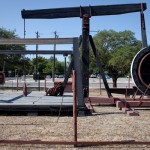Knowing Your Neighbor When Deadly Chemicals Are Next Door

Laura Isensee / Houston Public Media
Plants handling dangerous chemicals work with communities through Local Emergency Planning Committees
The fertilizer explosion last month that killed 14 people — mostly firefighters — in the town of West is an example of the danger of using or storing large quantities of chemicals close to communities.
Another example came just last week when hydrogen chloride gas used for processing cottonseed leaked and caused the evacuation of residents in Lubbock.
For yet another example, you can look back 38 years to what happened in another small town in Texas.
A Cloud that Killed
In Denver City, a town of 4,500 south of Lubbock, Jack Watkins is now retired. But in 1975, he was working in the oil and gas drilling industry. He was also a volunteer firefighter.
Just before dawn on a Sunday morning in February that year, the fire department was called out to investigate reports of a gas cloud just outside town. What they found left Watkins with memories still vivid to this day.
“I was the first one that went in,” Watkins told StateImpact Texas. “You could see it kind of like a fog that morning. It was real wet and damp.”
Watkins knew that sort of weather could mean trouble, because it could allow a gas cloud to concentrate instead of disperse. The source of the cloud was a leak at an “experimental” well for injecting hydrogen sulfide gas into an oilfield. Hydrogen sulfide is a naturally occurring gas and a danger around drilling and production sites.
Seeing the cloud, Watkins said he donned an air pack and approached a house with vehicles in the driveway. He would later learn that the people who lived there were having a family reunion that weekend and had guests who stayed overnight.
“There was eight people there at the house. Dead. They’d run out and got in their cars and the gas was still in their cars. And they just got in their cars and the gas got them there,” Watkins said.
Tragedies Prompt Changes
The tragedy led the Railroad Commission of Texas, which regulates oil and gas drilling in the state, to require operators to have warning signs and fences around oil- and gas-producing sites where hydrogen sulfide gas is a danger. Years later, a far worse poison-gas disaster in Bhopal, India prompted the U.S. Environmental Protection Agency (EPA) to initiate the Risk Management Program.
The federal program requires facilities with large amounts of chemicals that could cause a major accident to work with local communities. Those communities have what are called Local Emergency Planning Committees or LEPCs. In Texas, the LEPCs are overseen by Department of Public Safety.
Nowhere might LEPCs be more critical than in Texas. With its proliferation of chemical plants, especially along the Gulf Coast, the state has more facilities handling dangerous chemicals than any other, according to reports compiled using EPA data.

Laura Isensee / Houston Public Media
Cheryl Vital is on the Galena Park Local Emergency Planning Committee
In the middle of the massive petrochemical complex along the Houston Ship Channel is the community of Galena Park. One member of its LEPC is Cheryl Vital, whose day job is Director of Emergency Management for the Galena Park School District.
“Those plants will file regular reports with the LEPC with regard to what chemicals they have and the amounts they have. So the LEPC should know what’s in the community,” Vital said.
But she said the system sometimes doesn’t work when what she called “fly by night” operators rent property for short-term use.
“There have been some fire situations where the firemen have gone in and they’ve realized they didn’t know a certain chemical was in that facility,” said Vital.
‘A Very Safe Plant’ Uses a Very Dangerous Gas
One longtime chemical facility located within a mile of homes in Galena Park is the Arkema Production Plant. It uses hydrogen sulfide gas to make insecticides and other products.
“The process we use to manage that hazard is not to have much of it. So we have none of it in tanks,” said Dillard Meadows, Arkema’s plant manager. “We have analyzers everywhere that read parts per million of (hydrogen sulfide). So if you had any kind of minor leak, you’d get an immediate signal that you have a leak which allows you to shut down immediately.”

Laura Isensee / Houston Public Media
Arkema plant manager Dillard Meadows talks with StateImpact's Dave Fehling outside the company's facility in Houston
Last year, the federal Occupational Safety and Health Administration (OSHA) cited the Arkema facility for alleged violations involving safety precautions related to the risk of “uncontrolled hydrogen sulfide vapor releases.”
Meadows said the citations were mostly for documentation issues. He said the plant is run safely and that management plays an active role in several local emergency groups including the LEPC.
“I’m very comfortable we have a very safe plant,” Meadows said. He said he could see no scenario leading to a lethal threat to the community.
“Absolutely not to the public outside of the plant,” Meadows told StateImpact Texas.

